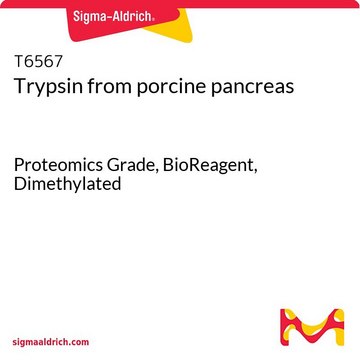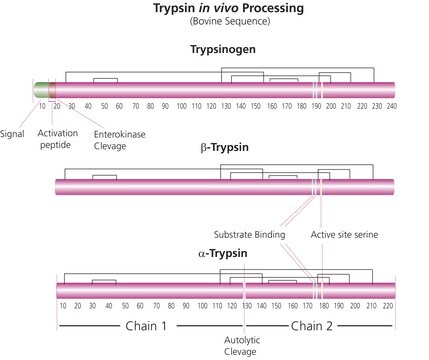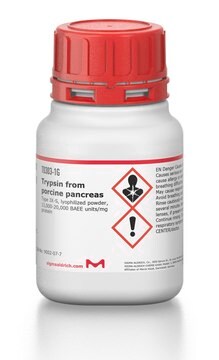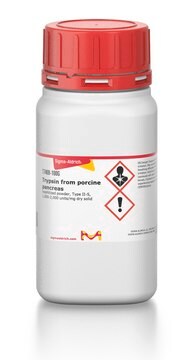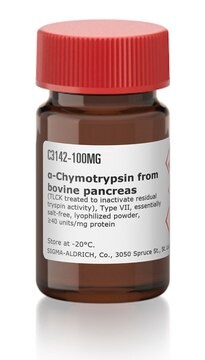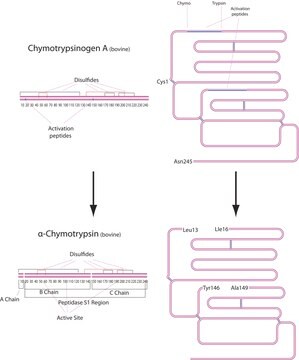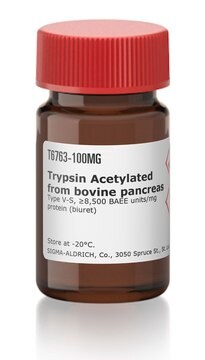T1426
Trypsin from bovine pancreas
TPCK Treated, essentially salt-free, lyophilized powder, ≥10,000 BAEE units/mg protein
Synonym(s):
Serine Protease 1
Sign Into View Organizational & Contract Pricing
All Photos(13)
About This Item
Recommended Products
biological source
bovine pancreas
Quality Level
grade
Proteomics Grade
form
essentially salt-free, lyophilized powder
specific activity
≥10,000 BAEE units/mg protein
mol wt
23.8 kDa
solubility
hydrochloric acid: soluble 1 mM
application(s)
diagnostic assay manufacturing
foreign activity
Chymotrypsin ≤0.1 BTEE units/mg protein
storage temp.
−20°C
Looking for similar products? Visit Product Comparison Guide
Application
For trypsin digestion of peptides, use a ratio of about 1:100 to 1:20 for trypsin:peptide. The typical use for this product is in removing adherent cells from a culture surface. The concentration of trypsin necessary to dislodge cells from their substrate is dependent primarily on the cell type and the age of the culture. Trypsins have also been used for the re-suspension of cells during cell culture, in proteomics research for digestion of proteins and in various in-gel digestions. Additional applications include assessing crystallization by membrane-based techniques and in a study to determine that protein folding rates and yields can be limited by the presence of kinetic traps.
Biochem/physiol Actions
Trypsin cleaves peptides on the C-terminal side of lysine and arginine residues. The rate of hydrolysis of this reaction is slowed if an acidic residue is on either side of the cleavage site and hydrolysis is stopped if a proline residue is on the carboxyl side of the cleavage site. The optimal pH for trypsin activity is 7-9. Trypsin can also act to cleave ester and amide linkages of synthetic derivatives of amino acids. EDTA is added to trypsin solutions as a chelating agent that neutralizes calcium and magnesium ions that obscure the peptide bonds on which trypsin acts. Removing these ions increases the enzymatic activity.
Serine protease inhibitors, including DFP, TLCK, APMSF, AEBSEF, and aprotinin, amongst others, will inhibit Trypsin.
Serine protease inhibitors, including DFP, TLCK, APMSF, AEBSEF, and aprotinin, amongst others, will inhibit Trypsin.
Components
Trypsin consists of a single chain polypeptide of 223 amino acid residues, produced by the removal of the N-terminal hexapeptide from trypsinogen which is cleaved at the Lys - lle peptide bond. The sequence of amino acids is cross-linked by 6 disulfide bridges. This is the native form of trypsin, beta-trypsin. BETA-trypsin can be autolyzed, cleaving at the Lys - Ser residue, to produce alpha-trypsin. Trypsin is a member of the serine protease family.
Caution
Solutions in 1 mM HCl are stable for 1 year in aliquots and stored at -20°C. The presence of Ca2+ will also diminish the self-autolysis of trypsin and maintain its stability in solution. Trypsin will also retain most of its activity in 2.0 M urea, 2.0 M guanidine HCl, or 0.1% (w/v) SDS.
Unit Definition
One BAEE unit will produce a A253 of 0.001 per minute at pH 7.6 at 25°C using BAEE as a substrate.
Preparation Note
Soluble in 1 mM HCl at 1 mg/mL.
It is also TPCK-treated and dialyzed. Treatment with L-1-Tosylamide-2-phenylethyl chloromethyl ketone (TPCK) reduces the chymotrypsin activity which is usually present in trypsin.
It is also TPCK-treated and dialyzed. Treatment with L-1-Tosylamide-2-phenylethyl chloromethyl ketone (TPCK) reduces the chymotrypsin activity which is usually present in trypsin.
inhibitor
Product No.
Description
Pricing
substrate
Product No.
Description
Pricing
Signal Word
Danger
Hazard Statements
Precautionary Statements
Hazard Classifications
Eye Irrit. 2 - Resp. Sens. 1 - Skin Irrit. 2 - STOT SE 3
Target Organs
Respiratory system
Storage Class Code
11 - Combustible Solids
WGK
WGK 1
Personal Protective Equipment
dust mask type N95 (US), Eyeshields, Gloves
Choose from one of the most recent versions:
Already Own This Product?
Find documentation for the products that you have recently purchased in the Document Library.
Customers Also Viewed
Daniel Rittschof et al.
PloS one, 6(2), e16487-e16487 (2011-03-08)
Attachment strength of fouling organisms on silicone coatings is low. We hypothesized that low attachment strength on silicones is, in part, due to the interaction of surface available components with natural glues. Components could alter curing of glues through bulk
Jeffrey R Whiteaker et al.
Molecular & cellular proteomics : MCP, 10(4), M110-M110 (2011-01-20)
Stable isotope standards and capture by antipeptide antibodies (SISCAPA) couples affinity enrichment of peptides with stable isotope dilution and detection by multiple reaction monitoring mass spectrometry to provide quantitative measurement of peptides as surrogates for their respective proteins. In this
Yipu Lin et al.
Influenza and other respiratory viruses, 11(3), 263-274 (2017-02-07)
Two new subclades of influenza A(H3N2) viruses became prominent during the 2014-2015 Northern Hemisphere influenza season. The HA glycoproteins of these viruses showed sequence changes previously associated with alterations in receptor-binding properties. To address how these changes influence virus propagation
Joshua K Endow et al.
PloS one, 11(12), e0167802-e0167802 (2016-12-10)
PolyGly is present in many proteins in various organisms. One example is found in a transmembrane β-barrel protein, translocon at the outer-envelope-membrane of chloroplasts 75 (Toc75). Toc75 requires its N-terminal extension (t75) for proper localization. t75 comprises signals for chloroplast
B Mazel-Sanchez et al.
Journal of virology, 92(11) (2018-03-23)
Highly pathogenic influenza A viruses (IAV) from avian hosts were first reported to directly infect humans 20 years ago. However, such infections are rare events, and our understanding of factors promoting or restricting zoonotic transmission is still limited. One accessory
Our team of scientists has experience in all areas of research including Life Science, Material Science, Chemical Synthesis, Chromatography, Analytical and many others.
Contact Technical Service
